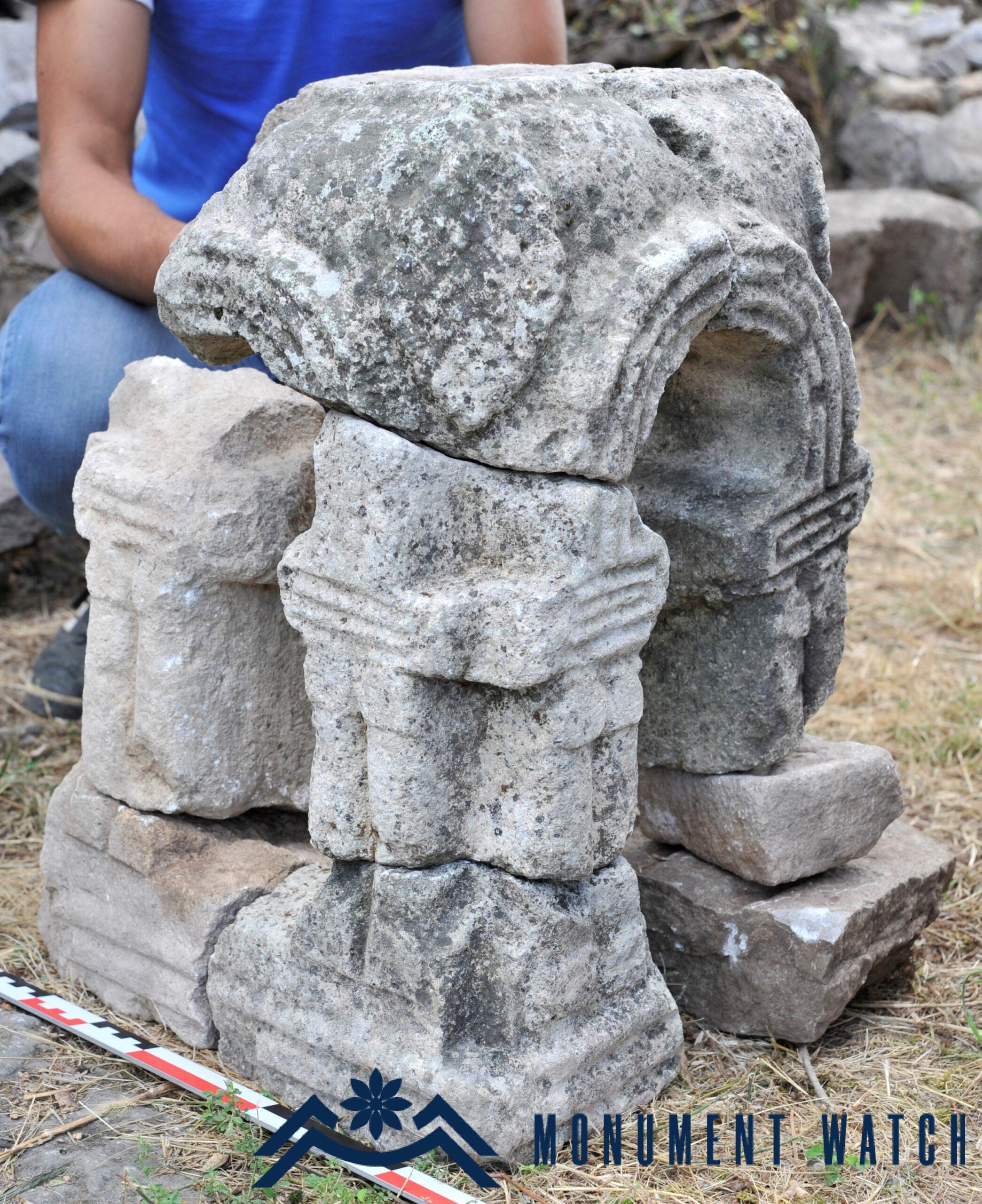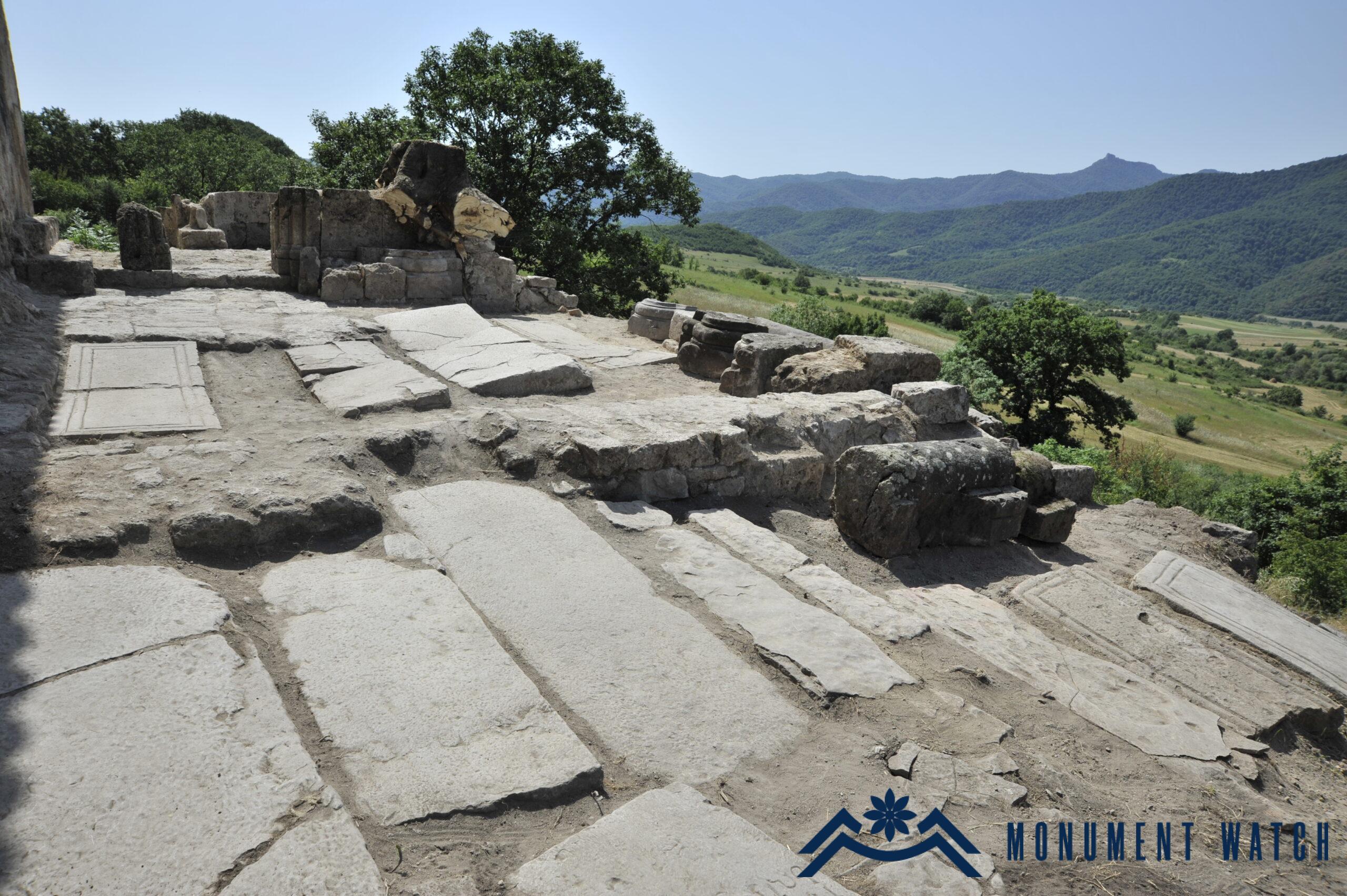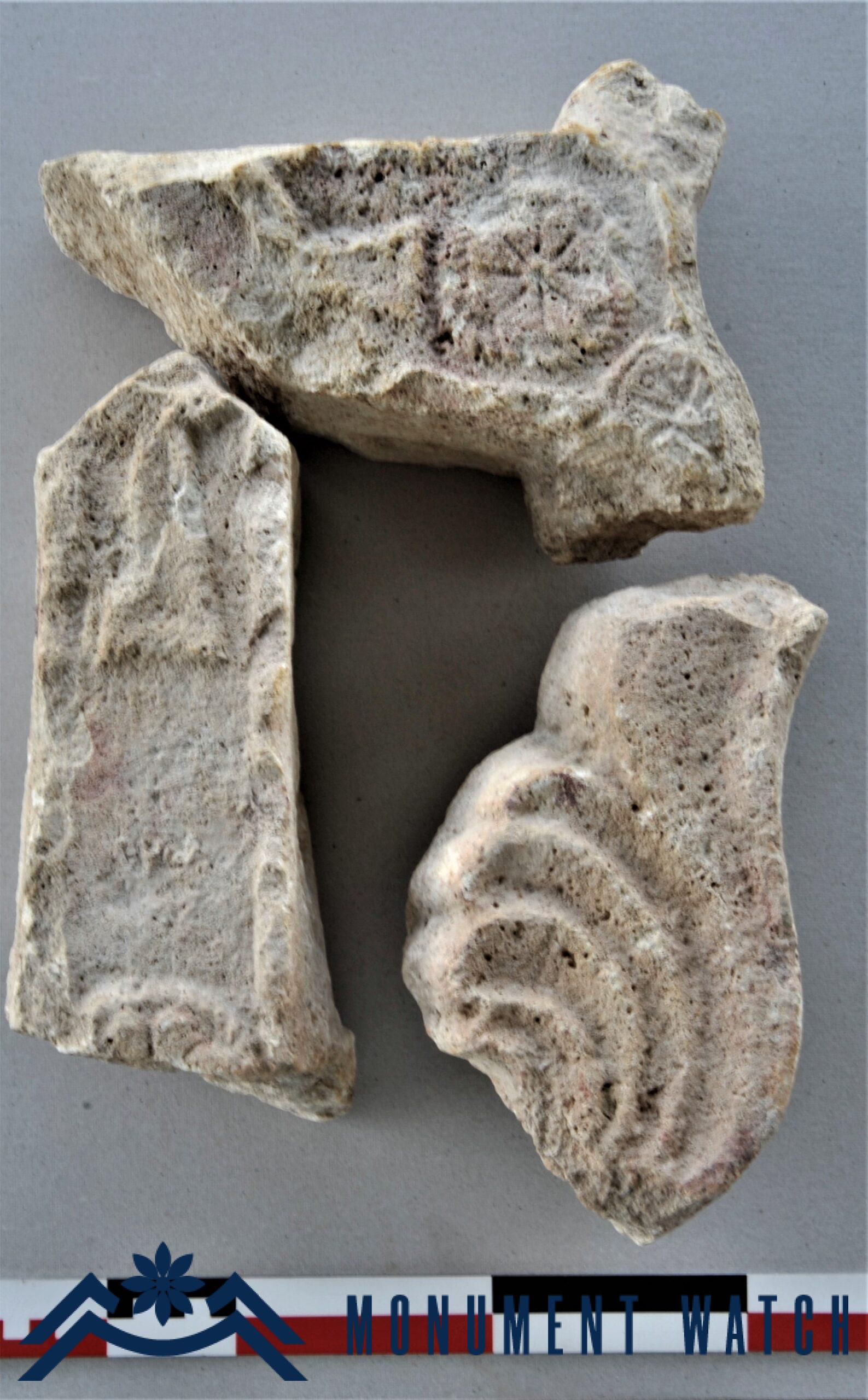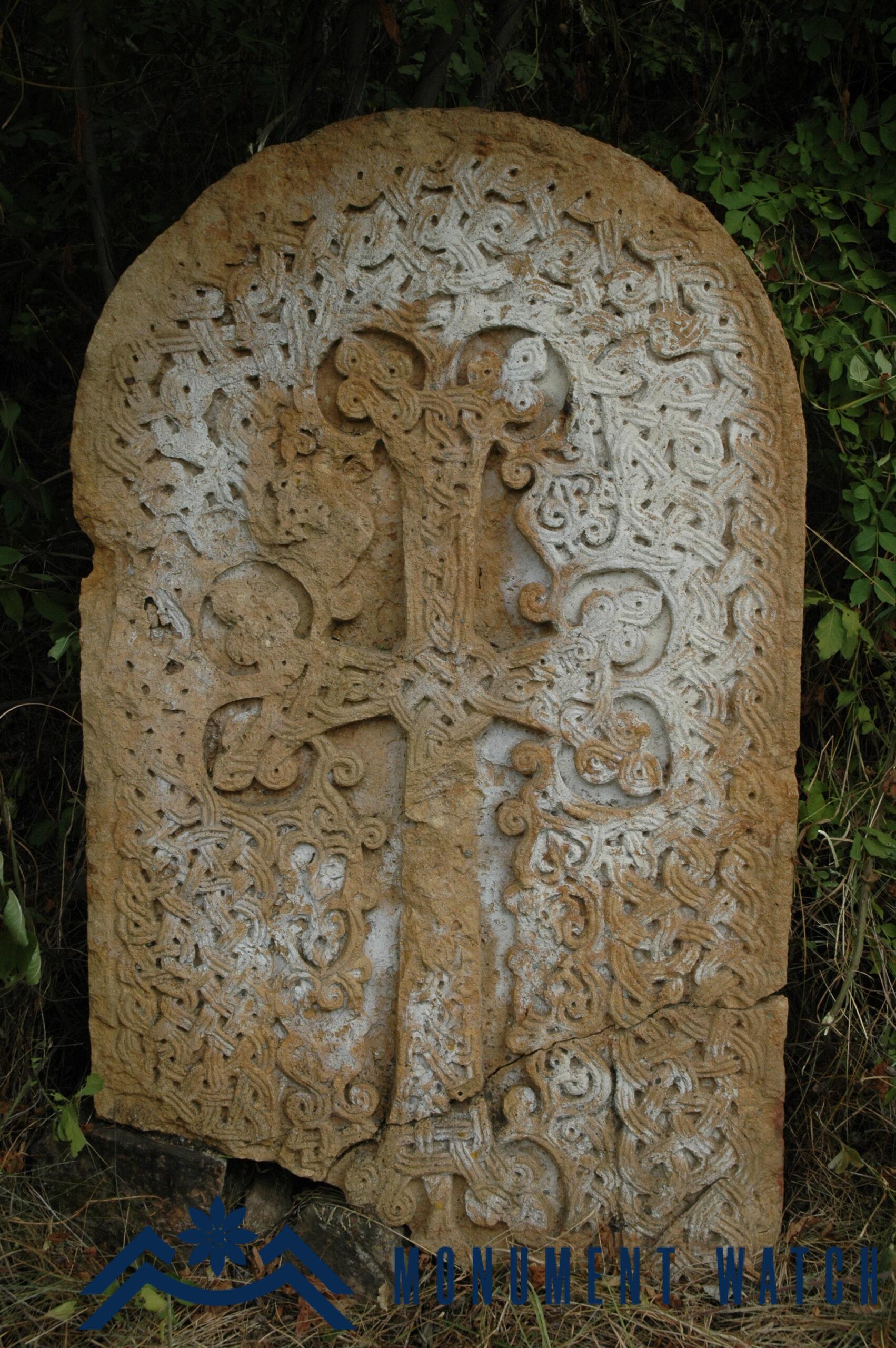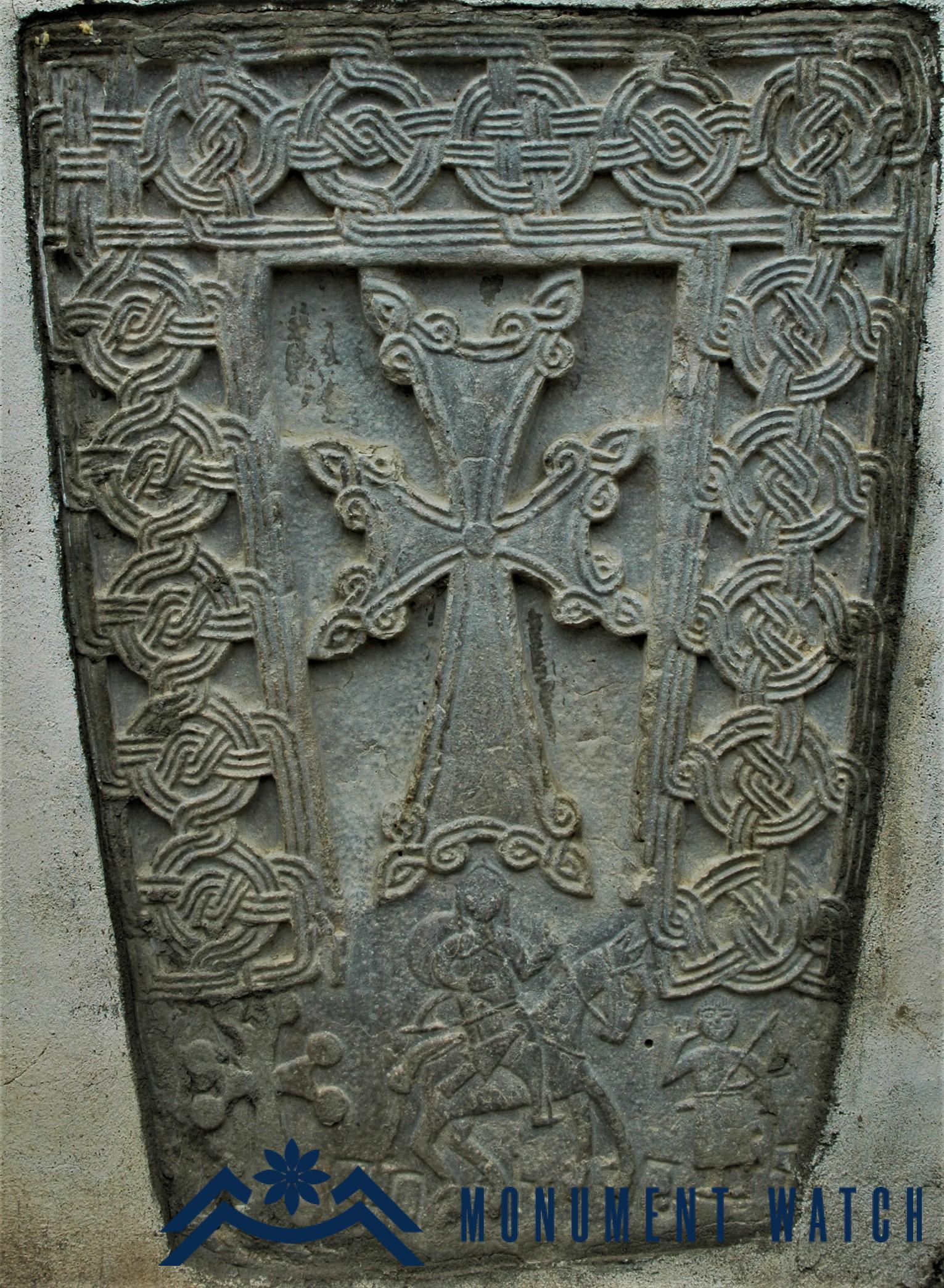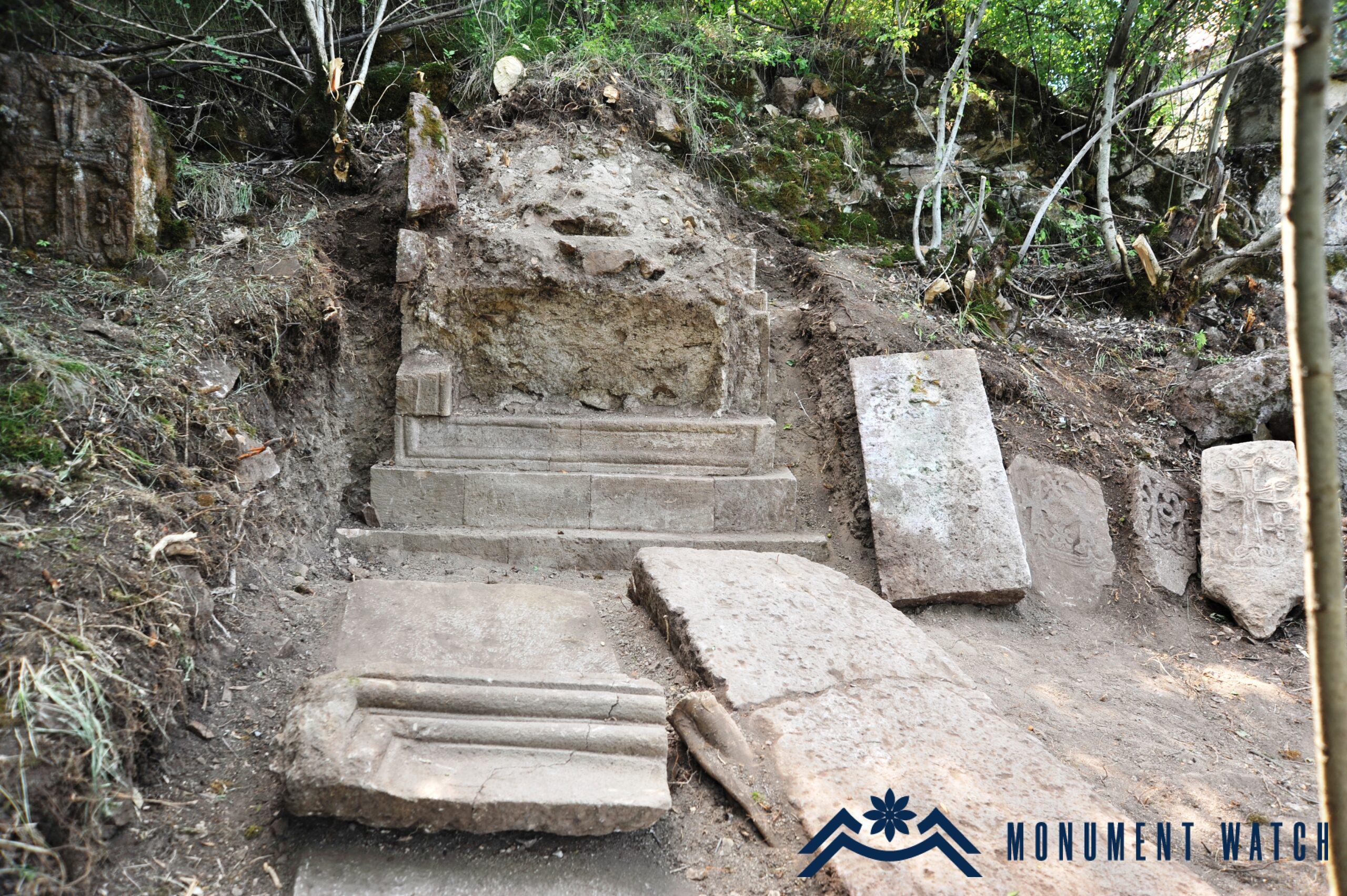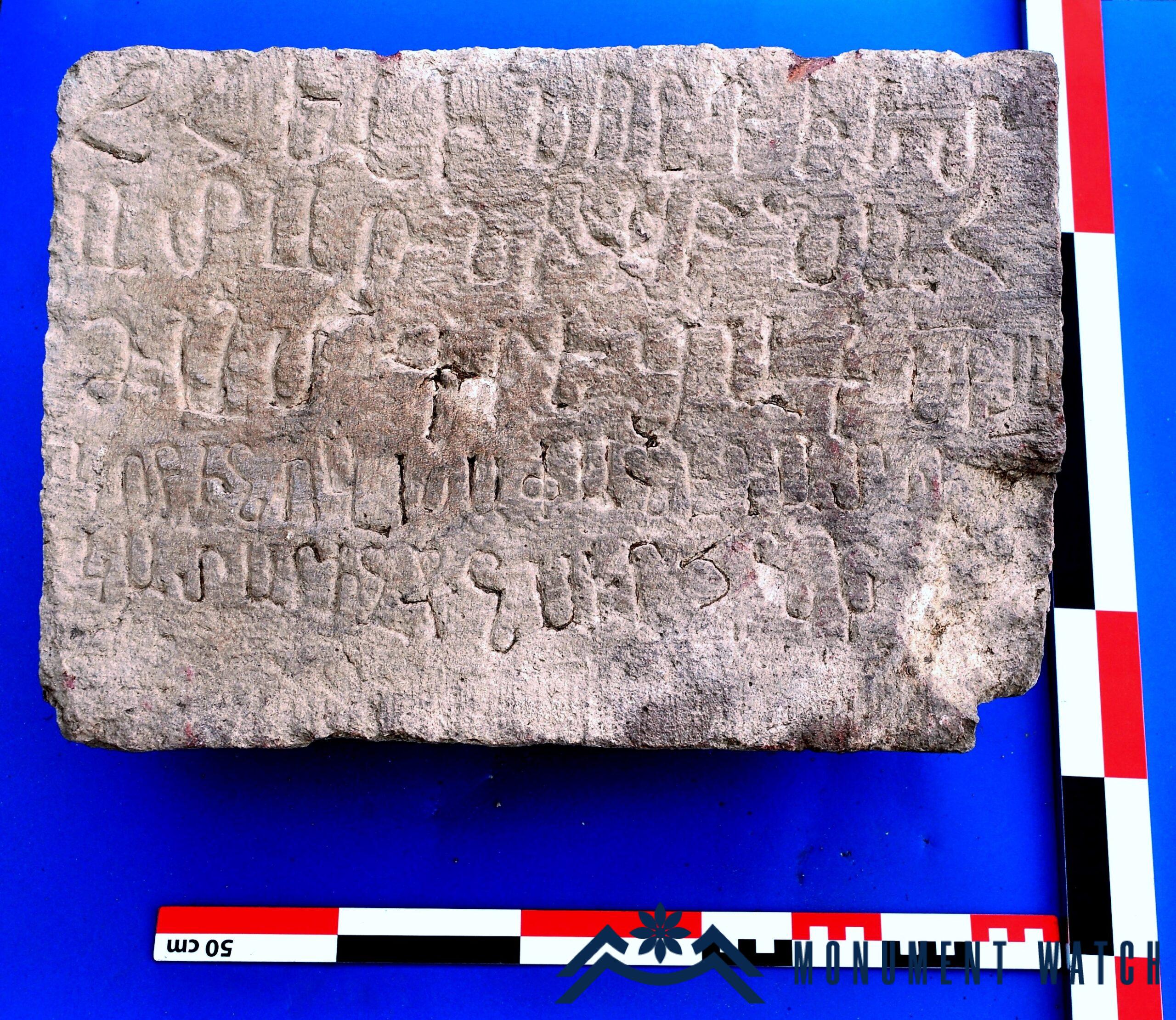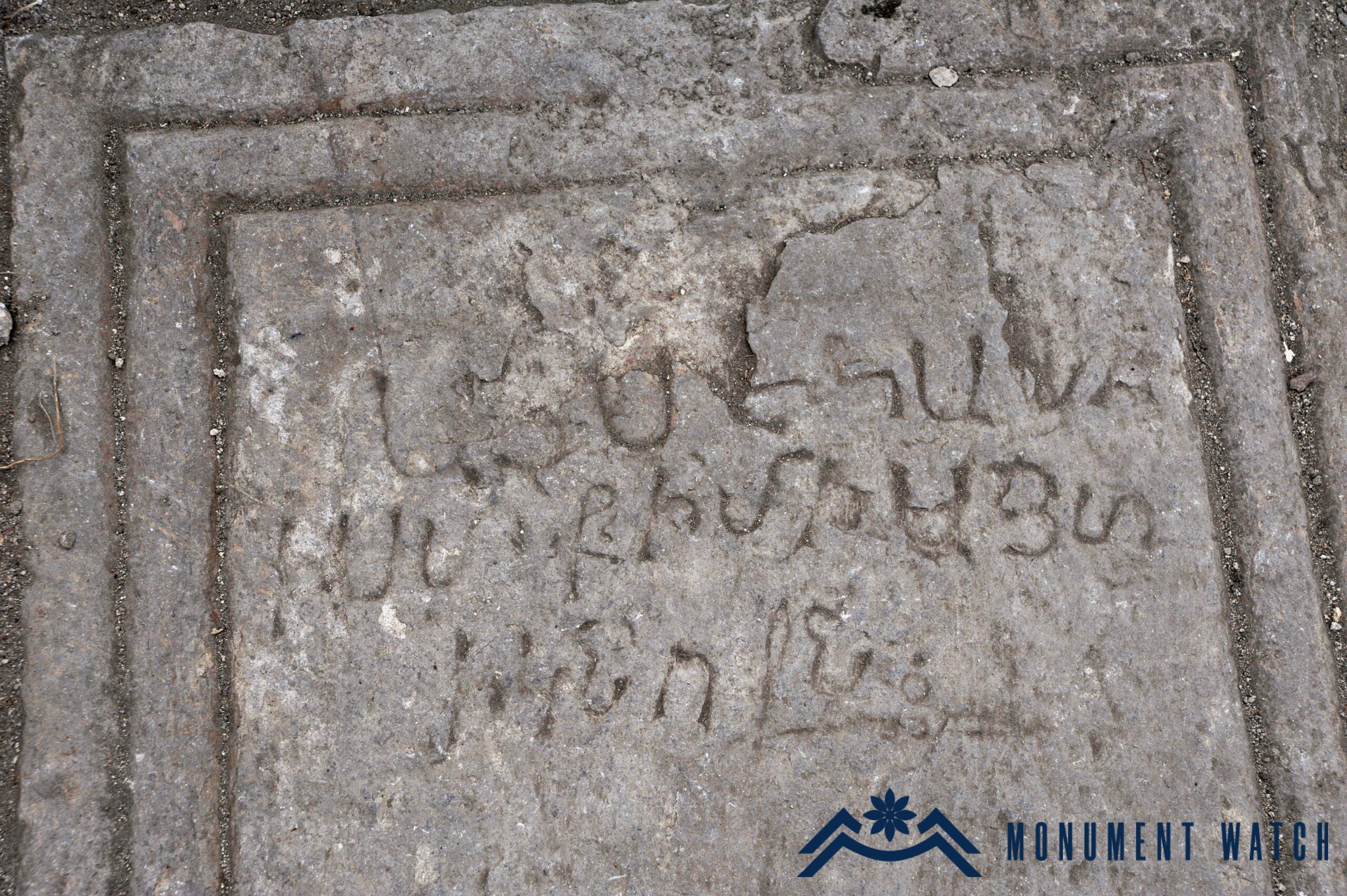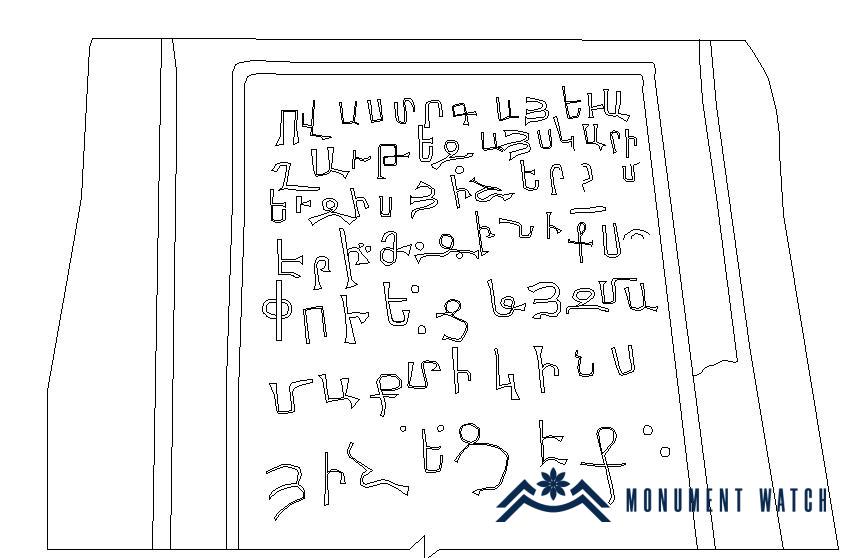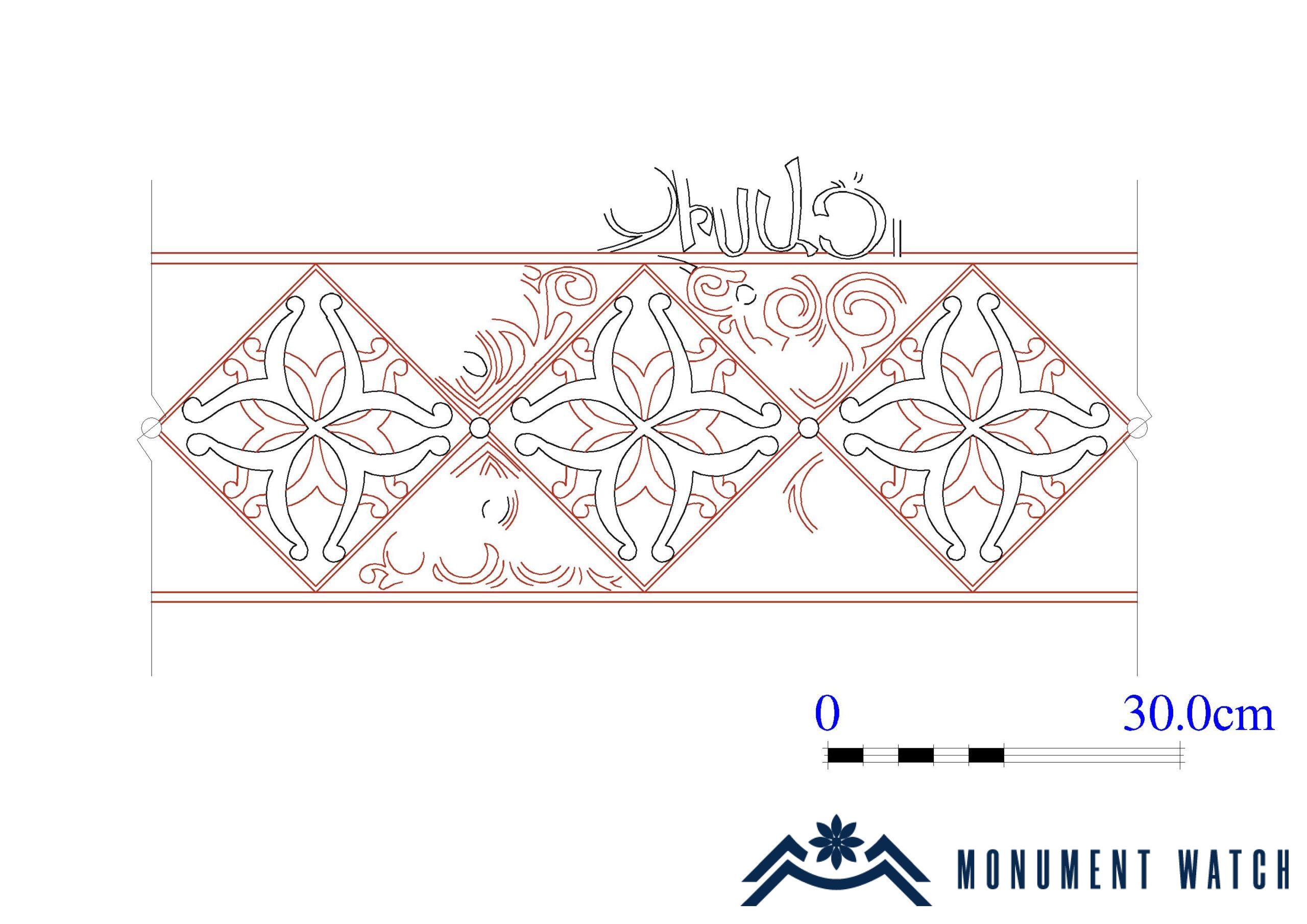Monuments and newly discovered inscriptions of Surb Stepanos Monastery of Vachar
The monuments
The discovery of the base of the cross and fragments of the winged cross during the monastery excavations holds exceptional significance for the early Christian culture of Artsakh (Figs. 1, 2). The findings suggest the possibility that an originally erected crusade monument adorned the roof of the reliquary. Typically, these crusade monuments comprise a pedestal, an anchor, an arch capital, a cross base, and a winged cross. In this particular instance, only the cross base and fragments of the winged cross have endured over time. Some fragments of that monument are discreetly embedded within the walls of Surb Stepanos Church. The base of the cross, dimensionally imitating the structure with an external open colonnade (tempieton) erected on the Lord's tomb, stands out not only for its architectural intricacies (multi-level anchors, four-column arches, horseshoe arches) but also for its ornate detailing. On the arches of the "roof," sizable bunches of grapes are intricately carved, symbolizing the redemptive crucifixion of Christ in early Christian iconography. This symbolism draws a parallel between the harvesting and crushing of grapes to produce divine wine and Christ shedding his blood on the cross for the salvation of humanity. The winged cross features palm decorations emerging from the base, supporting the horizontal wings, which terminate with flower-adorned lobes.

Excavations unveiled the presence of dedicated platforms adjacent to all structures within the complex, serving as tombs. Beyond the gavit burials, expansive open cemeteries were established in various locations, including the courtyards adjacent to Surb Stepanos Church from the west and east, in the southern courtyard of the chapel-reliquary, and the courtyards adjoining the gavit from the south and west (Fig. 3).
A notable portion of the graves contained upright khachkars that, over time, had fallen and were revealed during excavation. These khachkars, dating from the 12th to the 14th centuries, exhibit simple designs without inscriptions.
Two khachkars stand out in particular. The first one is notable for its arched dimensional solution and the proportional and skillful sculpture (Fig. 4). The second, relocated and erected in the contemporary cemetery west of the monastery (Fig. 5), is distinguished by sculptures of armed warriors on horseback and foot, accompanied by a brief inscription dating it to the year 1200.
To the northwest of Surb Stepanos Church, archaeologists excavated the remains of a burial structure, adorned with a walled khachkar (Fig. 6). In this area, in addition to large flat gravestones, several intact and fragmented khachkars, the base of the wall, and hewn fragments of the edges of the khachkar were discovered.
The newly discovered inscriptions
The inscriptions on the structures of the monastery, including some that no longer exist today, have been previously published (CAE 5, 78-82). Recent excavations have brought to light a dozen new inscriptions and fragments of inscriptions. These inscriptions include slabs on the walls of church structures with donation inscriptions, tombstones, and khachkar inscriptions. Noteworthy among them are the following:
A. Inscription from the slabs of the chapel, comprising 6 lines, with a regular majuscule writing (Fig. 7): "In 1274, I, Nerses, purchased gardens and subsequently dedicated them to Surb Stepanos. The Bishop and the congregation conducted two Masses (liturgies) in honor of Christ's Triumphal entry into Jerusalem."
B. From the slabs of the chapel, 5 lines with a regular majuscule writing (Fig. 8).
"The son of Jahel bestowed the forest upon the holy martyr. A single liturgy was scripted for the feast of St. Hakob. Whoever opposes it, let them be judged by God, and the one who carries it out, let him be blessed."
C. In the gavit, a polished tombstone stands adorned with highlighted pairs, displaying the inscription in three lines and featuring an irregular majuscule writing (Fig. 9).
"This marks the final resting place of Lady Kimia."
D. Situated in the southern yard of the chapel, another tombstone stands with a smooth, highlighted pair of edge furrows. The inscription spans seven lines, positioned at the upper part of the slab, encompassing all within irregular majuscule writing and perimeter letters (Fig. 10). "Whoever comes here and offers fervent prayers, please also remember me... On the 16th, lady Mamak transitioned into the embrace of Christ, keep her in your thoughts."
E. At the pinnacle of the bema mural, a conventional letterpress, executed in black paint, adorns a singular line. The inscription commences with the discernible associations "Mamak" and concludes with the reference "me, god" (Fig. 11).
Conclusions
Summarizing the findings from the investigation of the complex, we can delineate the following constructive-chronological process.
a. Originally, an early Christian chapel-reliquary stood on the site, featuring an eastern entrance. The tomb hall and entrance have been preserved in situ. Likely, the cross base and winged cross unearthed during excavations were originally part of the reliquary.
b. In the early 13th century, as the burgeoning princely house of Khachen sought new, pan-Christian patron saints, the relics of Saint Stepanos and the corresponding structure were "discovered."
c. In 1229, a new church was constructed adjacent to the reliquary from the northwest.
d. By 1251, a chapel had been built on the reliquary.
e. In 1284, a gavit was added to the chapel.
The construction of temples dedicated to pan-Christian (rather than local-traditional) saints by the Hasan Jalalyan princely house, such as Hovhannes Mkrtich of Gandzasar and Surb Stepanos of Vachar, aligns with a broader trend that emerged since the late 12th century. At that time, coinciding with the nascent Zakarian liberation struggle, Armenian ruling houses began actively engaging in the mission for the liberation of the Christian world as a whole.
In Artsakh, notable efforts were made by individuals such as Mkhitar Gosh and Reverend Vanakan to recognize Dado-Dadi-Dadui as the disciple of the apostle Thaddeus, with Dadivank being designated as an apostolic site. This mentality finds further expression in the mural paintings of Dadivank, including those directly linked to our monument, depicting the scene of the stoning of St. Stepanos on the northern wall of the Dadivank’s Katoghike Church. Various other instances underscore the broader ideological and geographical basis of this reality. For instance, the Proshyan princely house's acquisition of the relic of Noah's Ark and Saint Gehard, and in a more extensive context, the renaming of Masis to Ararat, are among the many facts that bear witness to this cultural and historical narrative. For instance, the Proshyan princely house's acquisition of the relic of Noah's Ark and Saint Gehard, along with the broader renaming of Masis to Ararat, reflects efforts to evoke a historical context wherein the Pan-Armenian War of Liberation and the Crusades played a role in disseminating a shared ideology centered on the liberation of the Holy Land. In this expansive perspective, the Holy Land encompassed nearly the entire Christian ecumene, including Armenia (Petrosyan 2019, 11-30).
What's particularly noteworthy is how this pan-Armenian mentality has found both ideological and material expression in the Surb Stepanos Monastery of Vachar.
Bibliography
- CAE 5 - Corpus of Armenian Epigraphy, issue 5, Artsakh/ made by S. Barkhudaryan, Yerevan, 1985.
- Petrosyan 2019 - Petrosyan H., The main results of the archeological research of the Saint Stepanos Monastery in Vat and newly discovered inscriptions, Sedrak Barkhudaryan 120. Collection of scientific articles, Yerevan, Science, pp. 11-30.
Monuments and newly discovered inscriptions of Surb Stepanos Monastery of Vachar
Artsakh
